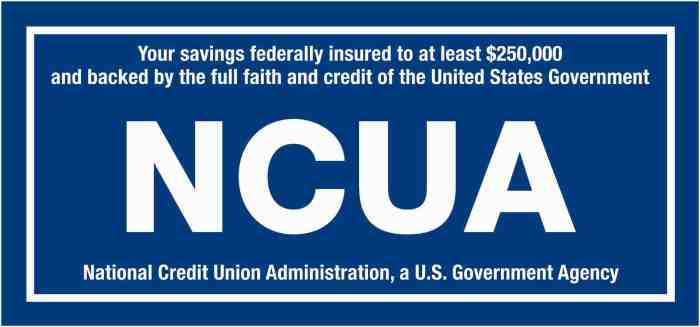What is FDIC insurance how does it work? This guide dives deep into the world of FDIC insurance, exploring its purpose, how it protects your savings, and the limits and exclusions you should know. We’ll cover the history, workings, and importance of this crucial banking safety net, making sure you understand how it protects your deposits.
From the agency that oversees the FDIC to the different account types covered, we’ll break down every aspect of this vital financial safeguard. Understanding the ins and outs of FDIC insurance empowers you to make informed financial decisions and protects your hard-earned money.
FDIC Insurance: Protecting Your Deposits

FDIC insurance is a crucial safety net for depositors in the United States. It provides a degree of protection against loss of funds if a bank fails. This insurance, administered by the Federal Deposit Insurance Corporation (FDIC), plays a vital role in maintaining public confidence in the banking system.
Purpose and Function of FDIC Insurance
The primary purpose of FDIC insurance is to safeguard depositors’ savings. By insuring deposits up to a certain limit, the FDIC reduces the risk of financial panic and instability within the banking sector. This function promotes public trust and encourages savings, fostering a stable financial environment.
History and Evolution of FDIC Insurance
The FDIC was established in 1933, in response to the widespread bank failures during the Great Depression. This landmark legislation aimed to restore public confidence in the banking system and prevent a repeat of the catastrophic economic fallout. Over the years, the FDIC has adapted its procedures and coverage limits to meet evolving financial needs. For instance, the agency has continually adjusted its insurance limits to keep pace with inflation, ensuring the protection remains relevant.
Overview of the Federal Deposit Insurance Corporation (FDIC)
The FDIC is an independent agency of the United States government. It’s responsible for ensuring the safety and soundness of the nation’s banking system. The agency’s primary function is to protect depositors’ money and maintain public confidence in the banking industry. Its operations are overseen by a board of directors, composed of individuals appointed by the President of the United States, subject to Senate confirmation.
Types of Accounts Covered by FDIC Insurance
The FDIC insures a variety of deposit accounts, ensuring a broad range of financial instruments are protected. The following table Artikels the different account types eligible for FDIC coverage.
| Account Type | Description |
|---|---|
| Checking Accounts | These accounts are commonly used for everyday transactions. They allow for easy access to funds and are frequently linked to debit cards for convenience. |
| Savings Accounts | Savings accounts encourage saving money over time and typically offer higher interest rates than checking accounts. |
| Money Market Accounts | These accounts provide a higher yield than traditional savings accounts but may have certain restrictions on withdrawal frequency. |
| Certificates of Deposit (CDs) | CDs represent a promise to pay a fixed sum of money at a specified future date, and they typically offer a higher interest rate compared to savings accounts, often for a set period. |
| Individual Retirement Accounts (IRAs) | These accounts are designed to help individuals save for retirement, and are often protected by FDIC insurance if held at a federally insured bank. |
How FDIC Insurance Works
FDIC insurance is a crucial safety net for depositors in US banks and savings associations. It provides a sense of security, knowing that their money is protected up to a certain limit. Understanding how this insurance works is essential for anyone holding accounts in these institutions.The FDIC’s primary function is to protect the public’s savings by insuring deposits held in eligible financial institutions.
This insurance safeguards against financial distress or failure of these institutions. It ensures that depositors can recover their funds, fostering public confidence in the banking system.
FDIC insurance protects your deposits in banks, ensuring your money is safe. It’s like a safety net, but what about other financial anxieties? With the potential for December’s payment being the last Child Tax Credit check, December’s payment could be the final child tax credit check, what to know it’s crucial to understand how this might affect your budget.
Ultimately, knowing about FDIC insurance gives you peace of mind, especially when navigating the financial landscape.
FDIC Insurance Coverage Process
The FDIC insurance process is designed to be transparent and efficient. It follows a clear pathway from deposit to protection. When a bank or savings association becomes federally insured, it automatically becomes subject to FDIC regulations and oversight. This process includes regular audits and assessments to ensure compliance and solvency.
Coverage Amount
The FDIC sets limits on the amount of insurance coverage per depositor, per insured bank, and per account type. This limit is not absolute and may change based on economic circumstances and legislative adjustments.
Currently, the standard coverage limit for most accounts is $250,000 per depositor, per insured bank.
This means that if a federally insured bank fails, depositors are protected up to this amount.
Role of the FDIC in Managing Insured Institutions
The FDIC plays a vital role in overseeing and managing insured institutions. This includes monitoring their financial health, ensuring compliance with regulations, and responding to potential crises.The FDIC’s oversight helps maintain the stability of the banking system. It also provides a framework for resolving any financial difficulties that may arise in insured institutions.
Step-by-Step Guide to the Insurance Process
- A depositor opens an account at a federally insured bank.
- The FDIC automatically insures the deposit up to the coverage limit.
- If the insured bank experiences financial difficulties and is declared insolvent, the FDIC steps in to manage the resolution process.
- Depositors are notified of the situation and provided with information on how to access their insured funds.
- The FDIC ensures the orderly distribution of insured funds to depositors.
Examples of Insured and Uninsured Accounts
This table demonstrates the difference between insured and uninsured accounts and the associated coverage amounts.
| Account Type | Insured/Uninsured | Coverage Amount |
|---|---|---|
| Checking Account | Insured | $250,000 |
| Savings Account | Insured | $250,000 |
| Money Market Account | Insured | $250,000 |
| Certificates of Deposit (CDs) | Insured | $250,000 |
| Retirement Account (IRA) | Insured | $250,000 |
| Joint Account | Insured | $250,000 per depositor |
| Non-Federally Insured Money Market Fund | Uninsured | Not covered |
| Brokerage Account (not held by insured bank) | Uninsured | Not covered |
Coverage Limits and Exclusions
FDIC insurance is a crucial safety net for your savings, but it’s not a limitless guarantee. Understanding the limits and exclusions is essential to accurately gauge the protection your deposits receive. This section delves into the specific coverage amounts for different deposit types and the circumstances where FDIC insurance doesn’t apply.Knowing the boundaries of coverage allows you to make informed financial decisions and avoid potential surprises.
We’ll explore examples of situations where coverage might be limited or excluded, clarifying the maximum amount of protection per depositor, per insured bank, and per account type.
Specific Coverage Limits for Different Deposit Types
FDIC insurance applies to various deposit accounts, but the coverage limits can differ based on the account type. It’s not a one-size-fits-all solution. This table provides a concise overview of common deposit types and their associated coverage amounts.
| Deposit Type | FDIC Insurance Limit |
|---|---|
| Checking Accounts | $250,000 |
| Savings Accounts | $250,000 |
| Money Market Accounts | $250,000 |
| Certificates of Deposit (CDs) | $250,000 |
| Individual Retirement Accounts (IRAs) | $250,000 |
Circumstances Where FDIC Insurance Does Not Apply, What is fdic insurance how does it work
FDIC insurance has specific exclusions to protect the system and ensure fairness. This section Artikels the conditions under which FDIC insurance doesn’t provide coverage.
- Non-deposit accounts: Insurance coverage is strictly limited to deposit accounts. Investments like stocks, bonds, or mutual funds held with a bank are not covered.
- Debts or loans: Borrowed funds, whether through personal loans or mortgages, are not covered by FDIC insurance. The protection is solely for deposits.
- Securities accounts: FDIC insurance does not extend to accounts holding securities, such as stocks, bonds, or mutual funds, even if maintained at a bank.
- Claims against bank officers or employees: Any claims or liabilities against bank officers or employees are not covered by FDIC insurance. This is separate from deposit protection.
Examples of Limited or Excluded Coverage
To further illustrate the limitations, let’s look at some examples:
- Joint accounts: If a couple has a joint account exceeding $250,000, the coverage is still limited to $250,000 per depositor, not the full amount. This means the protection is applied individually to each account holder.
- Multiple accounts at the same bank: Having multiple accounts at the same insured bank does not increase the overall coverage. The $250,000 limit applies to each account individually.
- Accounts held in trust: Trust accounts are treated similarly to individual accounts, with the coverage limit applying to each beneficiary individually.
Maximum Coverage Amounts
The FDIC insurance limit is a crucial aspect to consider. The maximum coverage per depositor, per insured bank, and per account type is a significant factor in protecting your funds.
FDIC insurance provides up to $250,000 per depositor, per insured bank, for each account type.
This means that if you have multiple accounts at the same bank, the coverage is not cumulative. Each account is protected up to $250,000.
Protecting Your Deposits
FDIC insurance is a crucial safety net for your savings, but it’s not a passive protection. Active measures you take as a depositor significantly enhance your security. Understanding how the insurance works and your responsibilities within the system are vital to safeguarding your deposits.Knowing your rights and responsibilities under FDIC insurance can prevent costly mistakes and ensure your financial well-being.
This involves more than just keeping your money in an insured institution; it’s about proactive steps to maintain security.
Steps to Protect Insured Deposits
Understanding the specifics of FDIC coverage allows you to take calculated steps to protect your deposits. This includes knowing your deposit limits and the types of accounts covered. A proactive approach to maintaining your financial security is essential.
- Review Your Account Details Regularly: Confirm the institution holding your deposits is FDIC-insured. Check your account statements frequently for any unusual activity or changes. This vigilance can help detect potential issues early.
- Diversify Your Deposits: Spread your funds across multiple insured institutions to mitigate risk. If one institution faces difficulties, your other accounts remain secure.
- Understand FDIC Insurance Terms and Conditions: Thoroughly review the FDIC’s terms and conditions for deposit insurance. This includes coverage limits and exclusions, allowing you to make informed decisions about where and how to deposit your funds.
- Choose FDIC-Insured Institutions Carefully: Research and select institutions with a strong financial history and a commitment to sound banking practices. Review the institution’s financial health ratings and stability before opening accounts.
Recommendations for Maintaining Financial Security
Proactive measures to maintain your financial well-being are essential. These measures include regularly reviewing your accounts and diversifying your deposits.
FDIC insurance protects your deposits, ensuring your money’s safe. It works by guaranteeing your funds up to a certain amount if a bank fails. Interestingly, the availability of Apple CarPlay in new vehicles, like the details on apple carplay vehicle availbility 200 , often depends on the manufacturer and model. Knowing how this insurance safeguard works is crucial for financial peace of mind, especially in today’s market.
- Monitor Account Activity: Regularly check your account statements for any unusual transactions or account changes. Promptly address any suspicious activity.
- Maintain Strong Passwords and Security Measures: Use strong, unique passwords for online banking and other financial accounts. Enable two-factor authentication wherever possible for added security.
- Keep Important Documents Secure: Safeguard essential documents like account statements, insurance policies, and tax records. Consider storing copies in a separate, secure location.
- Be Wary of Phishing and Scams: Be cautious of unsolicited emails or phone calls requesting your personal or financial information. Never share sensitive information with unknown sources.
Importance of Understanding Insurance Terms
A clear understanding of the terms and conditions of FDIC insurance is crucial for making informed decisions about your financial well-being. This knowledge is essential for maximizing the protection offered by the insurance.
- Knowing Coverage Limits: Understanding the maximum amount the FDIC will cover for each account type is vital. This knowledge helps you determine the appropriate amount to deposit in various accounts.
- Understanding Exclusions: Knowing what types of accounts or assets are not covered by FDIC insurance is crucial for making appropriate financial decisions. This includes understanding the limits and exclusions to prevent surprises.
- Staying Informed About Changes: The FDIC periodically updates its insurance terms and conditions. Staying informed about these changes is essential to ensure your deposits are adequately protected.
Strategies for Selecting Insured Institutions
Selecting insured financial institutions requires careful consideration and research. This involves evaluating factors such as financial stability and reputation.
- Research Financial Stability: Look for institutions with a solid financial history and a strong reputation. Consider the institution’s capital adequacy ratios and overall financial health.
- Review Regulatory Compliance: Ensure the institution complies with all relevant regulations and guidelines. Look for institutions that demonstrate a commitment to responsible financial practices.
- Seek Recommendations: Ask trusted friends or family for recommendations regarding financial institutions they have experience with. Seek feedback from people who have had dealings with the institution.
Best Practices for Deposit Security
Implementing best practices can significantly enhance deposit security and financial well-being. These practices are essential to mitigate potential risks.
| Risk Category | Best Practice |
|---|---|
| Financial Instability of Institution | Thorough research and evaluation of the institution’s financial health, regulatory compliance, and reputation. |
| Unauthorized Access | Strong passwords, multi-factor authentication, and vigilance against phishing attempts. |
| Economic Downturn | Diversification of deposits across multiple insured institutions and maintaining a balanced financial strategy. |
| Fraudulent Activities | Regular monitoring of account activity, reporting any suspicious transactions immediately, and being cautious of unsolicited requests for personal information. |
FAQs and Common Misconceptions
Understanding FDIC insurance can be tricky, with a lot of nuances and potential misunderstandings. This section tackles common questions and misconceptions surrounding the FDIC’s role in protecting your deposits. We’ll clear up any ambiguity and ensure you have a complete understanding of how the insurance works in practice.
FDIC insurance protects your deposits in banks, ensuring your money is safe. It works by guaranteeing a certain amount of your savings if a bank fails. Speaking of financial security, I recently stumbled upon a fascinating interview about the cover reveal for Myke Cole’s The Sacred Throne: Armored Saint, a cool fantasy grim cover reveal interview.
This really got me thinking about how vital FDIC insurance is for peace of mind when dealing with financial institutions. Ultimately, knowing your money is safe is a great comfort.
Common Questions About FDIC Insurance Coverage
This section addresses frequently asked questions regarding FDIC insurance coverage, aiming to clarify any uncertainties. These questions often arise due to the complexities of financial institutions and the nuances of insurance policies.
- What types of accounts are covered by FDIC insurance?
- FDIC insurance covers most deposit accounts, including checking accounts, savings accounts, money market accounts, and certificates of deposit (CDs). However, there are specific types of accounts and instruments not covered by the FDIC insurance program. This includes, for example, accounts held in trust, or accounts where the depositor has a specific arrangement with the financial institution that deviates from the standard practices for deposit accounts.
Furthermore, some investment products, like stocks and bonds, are not covered.
- What is the coverage limit for FDIC insurance?
- Currently, the FDIC insurance coverage limit is $250,000 per depositor, per insured bank, for each account ownership category. This means if you have multiple accounts at the same bank, the total coverage across all those accounts is capped at $250,000 per category. For example, if you have a joint account and an individual account at the same institution, the combined coverage is still capped at $250,000 per category.
This important limitation ensures the protection of many depositors and prevents any single depositor from overwhelming the insurance fund.
- How long does it take for the FDIC to pay out insured deposits after a bank failure?
- The FDIC works diligently to process payouts as quickly as possible following a bank failure. However, the timeframe can vary depending on the complexity of the situation, including the size of the institution, the number of depositors, and the overall administrative procedures. Generally, the payout process takes a considerable amount of time, but the FDIC aims to resolve the situation as efficiently as possible.
Common Misconceptions About FDIC Insurance
Misconceptions about FDIC insurance can stem from a lack of clear understanding of its scope and limitations. This section clarifies potential misinterpretations.
- FDIC insurance guarantees the safety of all investments.
- FDIC insurance covers all types of accounts and investments held at a financial institution. However, not all accounts or investments are protected by FDIC insurance. For example, investment products such as stocks and bonds are typically not insured by the FDIC. The coverage is limited to insured deposit accounts, not broader investment portfolios.
- FDIC insurance covers deposits held in multiple accounts at the same institution.
- FDIC insurance coverage applies to all accounts held by a single depositor, but it’s crucial to remember the $250,000 limit per depositor, per insured bank, for each account ownership category. This limit applies per insured bank, meaning that if you have deposits in multiple banks, the protection will be limited to $250,000 per institution. Therefore, maintaining a diverse range of accounts across various institutions can enhance overall protection.
Summary of FAQs and Answers
This table summarizes common questions and their corresponding answers, providing a quick reference for understanding FDIC insurance.
| Question | Answer |
|---|---|
| What types of accounts are covered? | Most deposit accounts, including checking, savings, money market, and CDs. |
| What is the coverage limit? | $250,000 per depositor, per insured bank, per account ownership category. |
| How long does payout take? | Timeframes vary based on the circumstances of the bank failure. |
| Does FDIC insurance guarantee all investments? | No, only insured deposit accounts are protected. |
| Does FDIC insurance cover multiple accounts at the same institution? | Yes, but the total coverage is capped at $250,000 per depositor, per insured bank, per account ownership category. |
FDIC Resources and Contact Information
Staying informed about your financial security is crucial, especially when dealing with institutions safeguarding your deposits. The Federal Deposit Insurance Corporation (FDIC) provides extensive resources to help you understand your rights and responsibilities. This section details the FDIC’s official channels for accessing information, filing complaints, and contacting support.Knowing how to navigate these resources can empower you to make informed financial decisions and protect your hard-earned money.
FDIC Website and Resources
The FDIC’s website serves as a comprehensive hub for information about deposit insurance, bank failures, and financial literacy. It offers a wealth of resources, including publications, FAQs, and educational materials. The website’s user-friendly design and clear explanations make it an excellent starting point for anyone seeking information on the FDIC’s role and responsibilities.
Contacting the FDIC
The FDIC provides various ways to contact them for assistance or inquiries. This includes phone numbers, email addresses, and mailing addresses. Understanding these channels can help you reach the appropriate department for your specific needs.
- The FDIC’s website features a detailed contact page with various options to reach them. You can submit inquiries online, call a dedicated phone line, or send mail to a physical address. These different options cater to different needs and preferences.
Filing Complaints or Inquiries
The FDIC has established a clear process for handling customer complaints and inquiries. This includes detailed instructions on how to file a complaint and the expected timeframe for responses.
- The FDIC offers online complaint forms, which provide a convenient way to document issues and receive updates. These forms typically request specific details to facilitate a thorough investigation.
- Filing a complaint directly through the FDIC’s website ensures a formal record of the issue, facilitating faster resolution.
Accessing FDIC Publications and Reports
The FDIC publishes various reports and publications, offering valuable insights into financial trends, bank performance, and deposit insurance practices. These materials can help you understand the intricacies of the financial system and make informed decisions.
- The FDIC’s website provides access to a wide range of publications, including annual reports, research papers, and special reports. These publications can offer insights into the state of the financial industry and the effectiveness of the FDIC’s policies.
- Many publications are available in downloadable formats, offering convenience for reviewing and sharing the information.
Official FDIC Resources and Contact Information
| Resource | Link |
|---|---|
| FDIC Website | [Insert FDIC Website Link Here] |
| FDIC Complaint Form | [Insert FDIC Complaint Form Link Here] |
| FDIC Contact Us Page | [Insert FDIC Contact Page Link Here] |
| FDIC Publications | [Insert FDIC Publications Page Link Here] |
| FDIC Reports | [Insert FDIC Reports Page Link Here] |
Concluding Remarks: What Is Fdic Insurance How Does It Work

In conclusion, what is FDIC insurance how does it work? FDIC insurance is a critical component of the U.S. financial system, safeguarding millions of depositors’ savings. By understanding the coverage limits, exclusions, and the importance of this insurance, you can confidently navigate the complexities of banking and protect your financial future. We’ve explored the intricacies, from the agency’s role to the protection of your deposits.
Armed with this knowledge, you can make sound financial choices.






